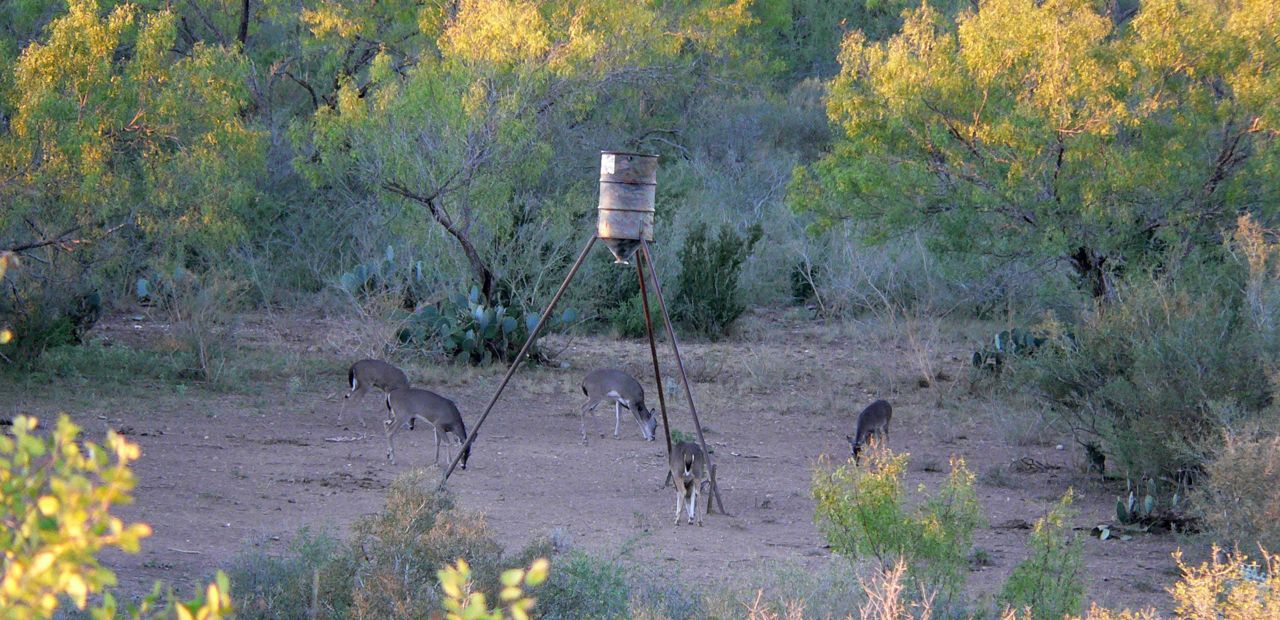

Leopold Live! Chapter 2: Food Stations Recap
September 13, 2021
Lights, camera, Leopold Live! Last month we premiered the fourth episode of Leopold Live!: Chapter 2 with our incredible partners at Selah, Bamberger Ranch Preserve, and we truly enjoyed getting to share even more about wildlife management practices through this series. Our hosts, Dr. Roel Lopez and Dr. April Sansom, introduced this new chapter of Leopold Live! and explained how new episodes will be a little different from what we covered in Chapter 1.
We began the episode with Bamberger ranch manager, Steven Fulton, to talk about different types of food stations and how they can be used in supplemental feeding of wildlife. On the ranch they mainly focus on providing supplemental food to their white-tailed deer herd. Before starting a supplemental feeding program there are some potential issues to keep in mind:
- Incidental feeding of non-target species (such as raccoons)
- Potential spread of disease
- How to exclude non-target species from feeders
There are a variety of food station types to choose from so Steven discussed each of them in more detail. The first was the slinging corn feeder. These feeders are designed to sling corn out in a 30-40 foot radius at set times each day to help attract deer species. Steven explains that corn is an incredibly effective bait because it is the food equivalent of soda for kids – full of sugar and has very minimal nutrition. This bait is an effective tool that managers use to lure animals into an area and make it easier to harvest the high numbers needed to maintain a healthy deer herd and landscape.
The next feeder type Steven talked about was a directional sling feeder. It functions similarly to the slinging corn feeder, except it throws feed in one direction instead of in a circle. This makes it so it can be used for both terrestrial and aquatic species (e.g., catfish in a pond) that you may want to feed on your property. One important note about both types of sling feeders is that they were designed to broadcast corn and may get clogged if they are filled with other types of feed.
So, what kind of feeder should you use if you want to provide something other than corn to wildlife? Free choice and gravity fed feeders are best to use if you want to feed supplemental protein pellets, particularly to your deer herd. Protein feeds can help individuals achieve more mature body and antler sizes at a younger age. Native deer species are not the only ones you can find munching on this extra food. Exotic deer and antelope species will also help themselves, often until they fill their bellies!
Although we displayed a variety of feeders throughout the episode, food plots are another viable option for providing supplemental food for wildlife on your property. Steve mentioned that if your management goal is to increase the body and antler sizes of your white-tailed bucks, this is not necessarily the best way to achieve it as food plots don’t provide enough extra protein to increase their growth. Food plots also require a lot of irrigation to grow well during drought conditions. In addition, when there is good rainfall on the landscape the native forage is more than adequate for deer nutritional requirements.
Deer are not the only species that can benefit from food plots though - Steven mentioned that on the ranch they have a one large food plot that they plant every year exclusively for birds. The seed mixture they use includes small-seeded plant species that birds prefer to feed on, including peredovik sunflower, iron and clay pea, and brown top millet.
We ended the episode with our usual Q&A session:
Do you have to provide supplemental feed all year round or only certain times of the year?
If you are trying to get or maintain wildlife tax valuation for your property it depends on your county tax assessor’s wildlife valuation requirements. Steven recommends feeding all year round and especially in spring and summer, which are potential drought periods here in Texas, so wildlife can put on the weight and fat stores needed to get through the winter.
What is a good feeder to area ratio for my property?
It’s going to depend on what part of the state you live in and the topography of your property, but a good rule of thumb is one feeder per 200 acres. On the Bamberger Ranch they have one feeder per 150 acres since they have quite a few hills and valleys on the property.
If you have any of these same questions or are just curious about food stations for wildlife, be sure to check out the full episode!
Leopold Live!: Chapter 2 is off to a great start, and our crew can’t wait to share our next episodes with you! Keep an eye on Facebook for new episodes to premiere every month.
Current Episode Schedule
Game Cameras - September 28th at 12:00pm
Supplemental Water - October 26th at 12:00pm
Herbicides and Brush Management - November 23rd at 12:00pm
Learn More
Private Land Stewardship Academies
Training land stewardship professionals working with private landowners and educating a community of practice on the importance of science-based conservation. Click Learn More for free access to resources.








